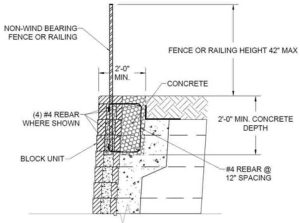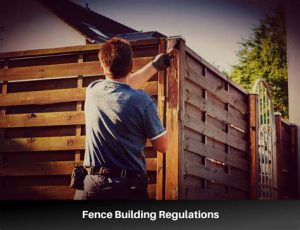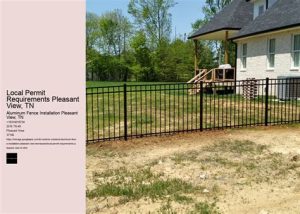Explore essential steps for navigating local permit requirements, zoning regulations, application submissions, approval timelines, and the risks of bypassing permits.Installing a fence can enhance your property’s aesthetics, provide privacy, and increase security. However, before you begin digging post holes or choosing materials, it’s crucial to navigate the often complex world of permits. Understanding local permit requirements is the first step in ensuring your project complies with regulations and avoids costly setbacks. Each municipality has its own zoning laws, which can affect everything from fence height to placement. This blog post will guide you through the essential steps of researching these regulations, submitting your permit applications, and understanding potential approval timelines. Additionally, we’ll discuss the serious consequences of skipping the permitting process, ensuring that your fence installation goes smoothly and legally. Let’s dive into the important details you need to consider before embarking on your fence project.
Understanding local permit requirements
Before embarking on your fence installation project, it’s crucial to understand the local permit requirements that may apply to your specific area. Local building codes and regulations can differ significantly, and failing to adhere to them can lead to costly repercussions.
Typically, most municipalities require a building permit for fence installations, particularly for structures over a certain height or those that encroach on easements. To identify the exact requirements, it is advisable to check with your city’s planning or zoning department. They can provide valuable information about the necessary permits, as well as any specific documentation you might need to submit.
- Height restrictions based on property lines.
- Restrictions on the type of materials allowed for fencing.
- Specific designs or styles that are permitted in certain areas.
- Setback requirements that dictate how far the fence must be from your property line.
Be proactive in gathering this information early in your planning process to ensure that your fence installation proceeds smoothly and without legal complications.
Researching zoning regulations for your area
Before embarking on your fence installation project, it is crucial to understand the zoning regulations specific to your locale. These regulations can dictate several aspects of your fence, including its height, material, and placement relative to property lines. Each city or municipality may have distinct rules, and overlooking them can lead to complications down the line.
To begin your research, visit your local government’s official website. Many cities provide resources including downloadable zoning maps and guides that outline the restrictions applicable in your area. Additionally, you can often find contact information for the planning department, where you can seek clarification on any confusing regulations.
If the online resources do not provide enough information, consider reaching out to neighbors who have recently gone through the fence installation process. Their experiences can shed light on potential zoning challenges you may face. Moreover, engaging with a local contractor familiar with the area’s regulations can be an invaluable asset in ensuring that your fence project stays compliant.
Submitting permit applications to the city
When you’re ready to move forward with your fence installation, one of the most important steps is submitting permit applications to the city. This process may vary depending on your local regulations, but it typically involves a few key steps that are crucial to ensure your project is legal and compliant.
Before submitting your application, make sure you have all the necessary documentation prepared. This may include your property survey, detailed plans for the fence, and any other relevant materials. It is also wise to check with your local planning office to confirm what specific documents are required in your area.
Once your application is complete, you’ll need to submit it along with any required fees. Be aware that processing times for permit applications can differ significantly between cities, so it’s advisable to submit your request well in advance of your planned installation date. By doing so, you can avoid potential delays and ensure your project stays on schedule.
Reviewing potential permit approval timelines
When planning your fence installation, understanding the permit approval timelines is crucial to ensure your project progresses smoothly. Different jurisdictions have varying timelines based on several factors, including their backlog of applications and the complexity of the proposed project.
| Phase | Typical Duration |
|---|---|
| Application Submission | 1-2 weeks |
| Initial Review | 2-4 weeks |
| Public Notice Period | 2-4 weeks |
| Approval/Denial Notification | 1-3 weeks |
Each phase can be influenced by a variety of factors, such as the current workload of the planning office, the need for additional documentation, or community feedback during the public notice period. Be proactive by checking with your local planning authority for any specific timelines related to your fence installation permit application.
Additionally, if any issues arise during the review process, such as the need for modifications to the plan or further consultations with neighbors, this could extend the timeline. Therefore, it’s advisable to factor in some extra time when planning your project, as waiting for permit approval can significantly impact your installation schedule.
In summary, while most permits may be approved within a few weeks, it’s essential to remain flexible and informed about the potential delays and processes involved. With adequate preparation, you can navigate the permit approval timeline more effectively and ensure a successful fence installation.
Potential consequences of not obtaining permits
When planning a fence installation, neglecting to obtain the necessary permits can lead to serious implications. Homeowners often overlook this critical step, thinking that their project is straightforward and doesn’t require formal approval. However, failing to adhere to local regulations can result in various consequences that may become problematic in the long run.
One of the immediate risks of not securing a permit is the possibility of having to remove the fence altogether. If local authorities discover that a fence was installed without the proper approval, they may issue a removal order. This can be costly, not just in the materials and labor to dismantle the fence, but also in having to start the process of applying for permits after the fact.
Additionally, the absence of permits can lead to fines and penalties imposed by local government agencies. These can range from minor fees to significant financial burdens, which could easily be avoided by taking the time to secure the necessary approvals before commencing the project. Furthermore, not obtaining permits can negatively affect your home’s insurance coverage, leaving you vulnerable in case of damage or disputes related to your fence.
Lastly, consider the potential impact on your home’s value. Improperly documented installations can deter future buyers who are concerned about property compliance and local regulations.
Frequently Asked Questions
What are the main reasons for needing a fence installation permit?
Permits are generally required to ensure compliance with local zoning laws, property lines, and safety regulations.
How do I determine if I need a permit for my fence?
Check with your local government or zoning office to understand your district’s specific regulations regarding fence installation.
What documents do I need to provide for the fence permit application?
Typically, you need to provide a site plan, a description of the fence materials, height, and possibly a property survey.
Are there any common restrictions I should be aware of when installing my fence?
Restrictions can include height limits, style requirements, and specific materials that are allowed or prohibited.
What is the typical processing time for a fence permit application?
Processing times can vary, but they often range from a few days to several weeks, depending on local regulations and backlog.
Can I install my fence without a permit in certain situations?
In some areas, minor fences or repairs may not require a permit, but it is always best to check local laws to avoid fines or removal.
What are the consequences of installing a fence without the necessary permits?
Consequences can include fines, being required to remove the fence, or facing legal action from neighbors or local authorities.





